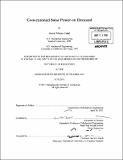| dc.contributor.advisor | Alexander H. Slocum. | en_US |
| dc.contributor.author | Codd, Daniel Shawn | en_US |
| dc.contributor.other | Massachusetts Institute of Technology. Dept. of Mechanical Engineering. | en_US |
| dc.date.accessioned | 2011-12-09T21:27:18Z | |
| dc.date.available | 2011-12-09T21:27:18Z | |
| dc.date.copyright | 2011 | en_US |
| dc.date.issued | 2011 | en_US |
| dc.identifier.uri | http://hdl.handle.net/1721.1/67579 | |
| dc.description | Thesis (Ph. D.)--Massachusetts Institute of Technology, Dept. of Mechanical Engineering, 2011. | en_US |
| dc.description | Cataloged from PDF version of thesis. | en_US |
| dc.description | Includes bibliographical references (p. 207-215). | en_US |
| dc.description.abstract | This thesis describes a new concentrating solar power central receiver system with integral thermal storage. Hillside mounted heliostats direct sunlight into a volumetric absorption molten salt pool, which also functions as a single tank assisted thermocline storage system. Concentrated light penetrates the molten salt and is absorbed over a depth of several meters; the molten salt free surface tolerates high irradiance levels, yet remains insensitive to the passage of clouds. Thermal losses to the environment are reduced with a refractory-lined domed roof and a small, closeable aperture. The molten salt and cover provide high and low temperature heat sources that can be optimally used to maximize energy production throughout the day, even when the sun is not shining. Hot salt is extracted from the upper region of the tank and sent through a steam generator, then returned to the bottom of the tank. An insulated barrier plate is positioned vertically within the tank to enhance the natural thermocline which forms and maintain hot and cold salt volumes required for operation. As a result, continuous, high temperature heat extraction is possible even as the average temperature of the salt is declining. Experimental results are presented for sodium-potassium nitrate salt volumetric receivers optically heated with a 10.5 kilowatt, 60-sun solar simulator. Designs, construction details and performance models used to estimate efficiency are presented for megawatt-scale molten salt volumetric receivers capable of operating with low cost nitrate or chloride salt eutectics at temperatures approaching 600 'C and 1000 'C, respectively. The integral storage capabilities of the receiver can be sized according to local needs, thereby enabling power generation on demand. | en_US |
| dc.description.statementofresponsibility | by Daniel Shawn Codd. | en_US |
| dc.format.extent | 216 p. | en_US |
| dc.language.iso | eng | en_US |
| dc.publisher | Massachusetts Institute of Technology | en_US |
| dc.rights | M.I.T. theses are protected by
copyright. They may be viewed from this source for any purpose, but
reproduction or distribution in any format is prohibited without written
permission. See provided URL for inquiries about permission. | en_US |
| dc.rights.uri | http://dspace.mit.edu/handle/1721.1/7582 | en_US |
| dc.subject | Mechanical Engineering. | en_US |
| dc.title | Concentrated solar power on demand | en_US |
| dc.type | Thesis | en_US |
| dc.description.degree | Ph.D. | en_US |
| dc.contributor.department | Massachusetts Institute of Technology. Department of Mechanical Engineering | |
| dc.identifier.oclc | 763241831 | en_US |
